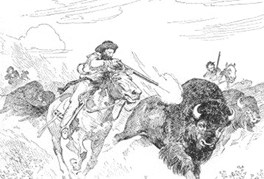Accounts of buffalo hunting written by witnesses are not found in great numbers in archival records. Once in a while your research leads to great historical finds and the following provides the reader with two outstanding examples. It was in 1818 that the international boundary between the Canadian and American Northwest had been agreed upon as the 49 degree parallel. Of course, for centuries the First Nations and Métis, who were the ones to frequent areas along this invisible boundary, were not part of the decisions. The boundary markers here and there along the line started being evident and meaningful only later in 1872-1873 when the Boundary Commissions on both sides officially marked the line. It was Métis hunters who knew the region well that the Dominion Government/Boundary Commission hired to guide, interpret, hunt, look after horses, etc of this survey party. In particular, the Métis of the Red River settlements had hunted and wintered at various locations, such as “La Montagne de Bois” or Wood Mountain, Montagnes Cyprès translated as Cypress Hills, in what is now Saskatchewan territory and the “Rivière Blanche” or Milk River in what is now Montana. Large brigades of hunters and their families would trek from their Manitoba homes in Red River carts, winding their way over the many trails crisscrossing the region. They were usually accompanied by a Roman Catholic missionary. From 1871 to 1882, reports and letters from the frontier were written for the most part by missionaries, some by other literate voyageurs. Excerpts translated from French are as follows: One letter was written by Father J. M. Lestanc to the Archbishop of St. Boniface, Mgr. Alexandre Taché.--October 8, 1873 --“We are always at the same place. The buffalo come regularly to visit us, every morning, and the hunters kill as many as they want. If the good weather continues and the buffalo herds do not change direction, we will need only a few more days to finish our task. There have been no accidents during three days of storms. The wintering quarters are the same as those of last year, that is to say Wood Mountain and the Milk River. My people are leaving today for Fort Benton, Montana, and I am entrusting them with this letter. Signed: J. M. Lestanc, priest. --The other, from Ambrose Lépine who had been a member of Riel’s Provisional Government, and had played a role in the Red River Resistance of 1868-70. He writes from the Cypress Mountains, on January 2, 1880: For the Métis, life had changed for the worst: The provisions are far from abundant in this part of the North West Territories. Many families have been obliged to leave the Cypress Mountains to make their way from here to the Milk River, in order to avoid greater misery. The buffalo are far away and for one month now the weather has been awful and extremely cold. The horses are too skinny for the hunt, which leaves the families’ situation very critical.--The abbreviated letters give us only a glimpse of the plight of the Métis. Not only was it a time of transition from their old way of life, but they had to live with prevailing prejudices. They were slowly being pushed west of the Red River country by the arrival of settlers from Eastern Canada and immigrants from many lands. They had been “emperors” of the prairie, had their own style of prosperity, had been sought after as expert guides not only by Boundary Commission but also by the North West Mounted Police from 1873 onwards.--Newcomers created a new society, a new class, a new prosperity, which had little comprehension of the old. (Copyright -Thérèse Lefebvre Prince—Previous publication in FOLKLORE Magazine.)
Contact Terri Lefebvre Prince,
Heritage Researcher,
City of Yorkton Archives,
Box 400, 37 Third Avenue North
Yorkton, Sask. S3N 2W3
306-786-1722
[email protected]




